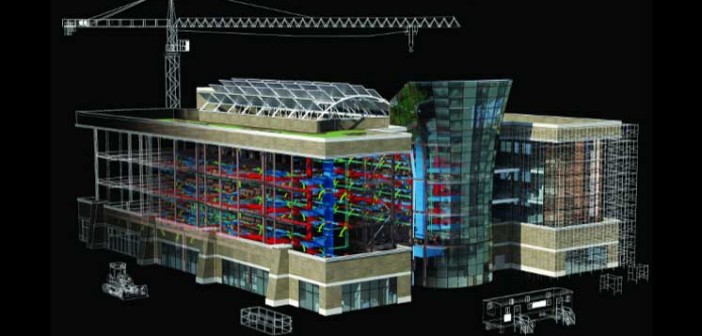The level of general BIM awareness among quantity surveyors is high, according to the Society of Chartered Surveyors of Ireland, but many QS practitioners have yet to fully realise how big an impact building information modelling is set to have on the way they work.
As procurement via building information modelling increasingly becomes the way in which construction projects are designed, delivered and maintained in the long-term, industry insiders are looking ahead to what level of BIM complexity will be adopted by various professions in the industry.
By now, most people in the industry in Ireland should know that a BIM mandate comes into effect in the UK next year, with all infrastructure projects mandated by central government having to be procured using Level 2 BIM capability. What this means is that while all parties may be using their own individual BIM models, the information contained within those models must be mutually compatible – design information must be shareable via common file formats.
By 2019, the UK government is hoping that all public contracts will reach Level 3 BIM capability which means using a single, shared project model held in a centralised repository. Extrapolating onwards, 4D BIM is using 3D virtual models that highlight dynamic change over time and 5D BIM which includes cost management.
Many think that it is at the 5D stage that quantifying and cost management professionals like quantity surveyors, estimators, cost managers and accountants will become involved with the BIM revolution, but not so. Electronic take offs from 2D CAD drawings, which were never meant to be shared widely among a project team, is now commonplace using estimating tools such as Exactal’s CostX solution. This means that QSs and costing specialists are entering the revolution at basement level or Level 0 BIM.
“The level of awareness among quantity surveyors using the term BIM in its correct context is probably 90-95%,” says Claire Crowley, chair of the BIM QS working group within the SCSI. “However, the level of awareness of BIM and its practical application, i.e. how it actually works for quantity surveyors, is probably between 30-40%. Most of our members have, at this point, been exposed to BIM theory and have a good understanding of its impact, current and future, to the quantity surveying profession. Due to limited BIM use and adoption in Ireland direct working experience remains limited at this point.
“SCSI members are welcoming BIM adoption, but at this point the benefits and added efficiencies are yet to be fully realised. BIM in Ireland, in the most cases, remains in its infancy. “
Exactal sales manager Craig Dorney says he believes that BIM adoption in Ireland is steadily growing. CostX now has a firm standing in the UK and is gaining a lot of traction in Ireland. It is not just QSs who are using the estimating software, quite a few contractors use it to price projects. All our customers would be using CostX for take offs from 2D drawings, but it is very simple to upgrade it to working with 3D drawings and BIM files. QSs are more likely to use CostX for 3D take offs, but some of the larger Irish contracting firms, those that are fully BIM ready, are also doing 3D take offs when preparing tenders and quotes.
“The main advantage of using CostX is that it can cut the time spent measuring by 80%, while also increasing accuracy. If you can get your estimating done more quickly, then you can get your tender bids and quotes out quicker that means you have a chance to take advantage of much more opportunities.” said Exactal sales manager Craig Dorney.
The leading Irish QS practice Bruce Shaw prides itself on being an early adopter of new technologies, says associate director Gary Comerford, and the firm has been using CostX for more than five years. “We moved to CostX during the recession to help prepare ourselves for the upturn and we now use it globally in all our offices,” he said. “CostX gives us the opportunity to measure far more effectively and makes us more efficient in the delivery of our services. It is a standard tool in all our offices, so it can be used by anyone within the company no matter where they might be posted to do a particular project.
Currently, Bruce Shaw employs about 450 people worldwide and is active in 40 countries and 150 cities. Founded in 1974, the company has 130 people employed at its headquarters in Dublin.
Gary Comerford said: “We use it primarily with 2D drawings – however, where there is a BIM model or a 3D model, all teams have the capability to deliver projects to BIM Level 2 standards. At the moment the industry is very much in the midst of a transition from 2D to 3D with 3D and BIM are becoming more common. The new National Paediatric Hospital and the relocation of the National Maternity Hospital are two projects that are being procured using Level 2 BIM and Level 2 BIM is also being used on the DIT Grangegorman campus.
“Within the industry the take up of BIM varies from profession to profession and from practice to practice – the largest practices have been early adopters of BIM and are at a more advanced stage because they are able to invest in the technology and training required. At Bruce Shaw we have on-going training with Exactal and we have CostX super-users within each team who are available to provide training on any particular aspect of using the software when required.
“The UK would be three to four years ahead of us because of the BIM mandate, which means that all public projects there will be effectively operating at Level 2 BIM from 2016 onwards. The mandate has meant that employer organisations have had to get behind the adoption of BIM and there has been a real push-pull within the industry there. I have an open mind as to whether there should be a BIM mandate in Ireland. Within the industry, there wouldn’t be a single point of view on the issue.”
Certainly, Claire Crowley cautions against imposing a facsimile of the UK government’s approach on to the Irish building industry. She said: “Ireland needs to tailor the solution to ensure its success; expectations should be scaled relative to the market size in Ireland with specific consideration to the supply chain capability.
“The aim here is the same as in the UK ‘To reduce the cost of government construction projects’ and to ‘improve cost, value and carbon’ performance’ and, in my opinion, the hypothesis behind a construction strategy for Ireland is the same ‘Ireland does not get full value from public sector construction and that it has failed to exploit the potential for public procurement of construction and infrastructure projects to drive growth’.
“Mandating BIM is a key part of the solution. The government, as a client, needs to align all departments and ensure that a clear mandate is responsive to an aligned set of objectives and requirements. Ireland should adopt the protocols and standards as developed by the UK government and, in most cases where BIM is in use in Ireland, it already has. There is no need to start over when it comes to guidance and standards – significant work has already been completed by the UK in this regard.
In summary, a BIM mandate introduced by Ireland must be realistic in terms of its objectives and what government as a Client can drive ‘pull’ and also what the capability of the market supply chain is at present.”
The need for reliable information within the BIM model was one issue for QSs that was highlighted by Comerford, Crowley and Dorney. “The data in the BIM needs to be intelligent and compatible with the agreed rules of measurement, said Comerford. “That is something that they are going through in the UK where they have new rules of measurement and we are going to have to standardise our procedures to ensure that we are getting good quality information from the designers. It is not enough to know how many walls, floors, doors and windows will be in a building, we need to have the finishes on all those elements properly categorised so that costs can properly be estimated.”
Crowley said: “Surveyors are tasked with utilising information received by designers and this can prove to be a challenging task. Depending on how BIM models are compiled the information can either be useful and add benefit, or it can be generated in a way that does not complement the surveyors working and measurement methods!
“In my experience, potential savings have been lost using BIM projects as effective collaboration is in its infancy. In reality where BIM data is used, traditional measurement occurs alongside this to validate the BIM data being provided. The agreed rules of measurement is a standalone document and remains relevant, however, the next step is to align this with designers BIM software via a coding system. A proposal for this has not yet been developed. For true collaboration to work and to ensure BIM data can be used by quantity surveyors, we need designers to understand how surveyors categorise and measure.”
There is hope that software solutions like CostX offer the potential for QSs to take on a greater role within building projects. Crowley explained: “Surveyors currently play a key role at project inception. BIM will enable the QS to provide enhanced services at this point and throughout the project. Surveyors will have more input into project/design feasibility as information is readily available. Surveyors, by nature, collate and review all design information; the role of BIM manager is something a surveyor could perform.”
This article first appeared in Irish building magazine
The contents of this site are subject to copyright laws and may not be reproduced in any form without the prior consent of the publishers. The views expressed in articles do not necessarily represent those of the publishers.




